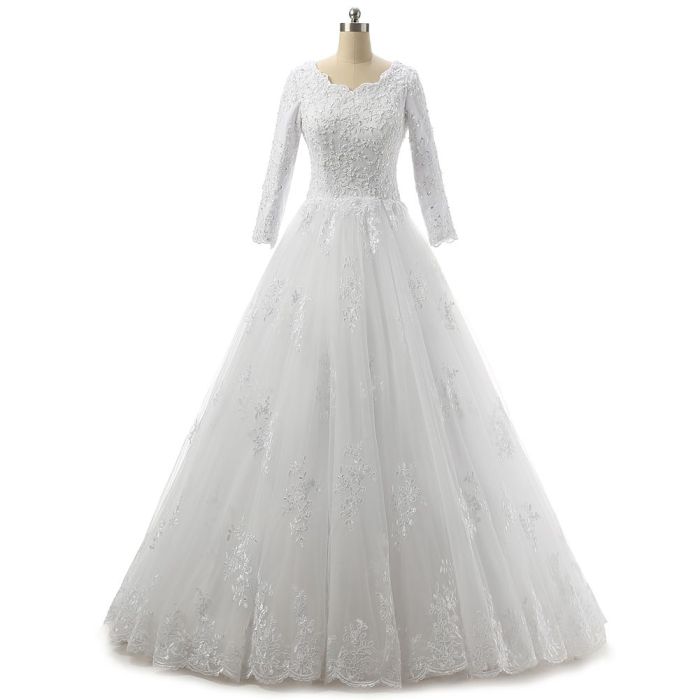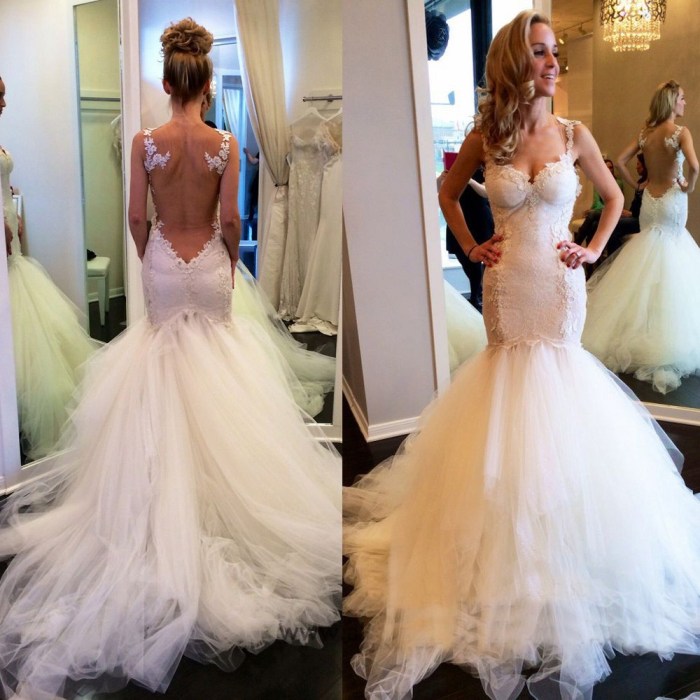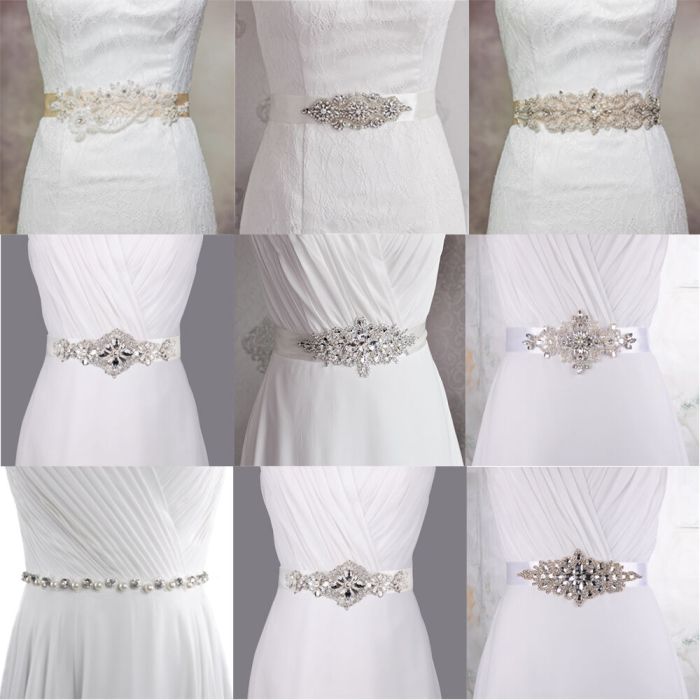Lace and Tulle Wedding Dresses: A Comprehensive Guide: Lace Tulle Wedding Dress

Source: dhresource.com
Lace tulle wedding dress – Lace and tulle are two fabrics that have long been associated with elegance and romance, making them popular choices for wedding dresses. This guide explores the characteristics of these fabrics, design possibilities, color combinations, and the manufacturing process involved in creating a stunning lace and tulle wedding gown.
Defining Lace and Tulle
Understanding the properties of lace and tulle is crucial for appreciating their use in wedding dress design. Lace, a delicate fabric created by intricate knotting or looping of threads, offers a variety of textures and patterns. Tulle, a sheer netting, provides a foundation for the lace and contributes significantly to the overall look and feel of the dress.
Lace types commonly used in wedding dresses include Chantilly lace (known for its delicate floral patterns and soft hand), Alençon lace (characterized by its intricate motifs and fine detailing), and Venise lace (a heavier, more structured lace with geometric patterns). Tulle varies in texture from soft and delicate to stiff and structured, with weights ranging from lightweight bridal illusion tulle to heavier, more substantial tulle used for creating volume in skirts.
Lace tends to drape more softly and conform to the body’s curves, while tulle offers a more structured, flowing drape, depending on its weight. The combination of lace’s intricate detailing and tulle’s airy texture creates a visually stunning and texturally rich effect, adding depth and dimension to the wedding dress.
Design Elements and Styles
The versatility of lace and tulle allows for a wide range of wedding dress silhouettes and design elements. Combining these fabrics effectively results in dresses that are both elegant and unique.
| Silhouette | Lace Placement | Tulle Usage | Overall Impression |
|---|---|---|---|
| A-Line | Appliqués on the bodice and skirt | Soft tulle overlay | Romantic and flowing |
| Mermaid | Intricate lace throughout the bodice and extending to the skirt | Tulle underlay for structure | Elegant and form-fitting |
| Ballgown | Lace bodice with tulle overlay | Layers of tulle for volume in the skirt | Grand and dramatic |
| Sheath | All-over lace | Subtle tulle lining | Sleek and sophisticated |
Lace appliqués can be strategically placed on tulle to create stunning visual effects. For instance, floral appliqués can be scattered across the skirt for a whimsical look, or concentrated on the bodice for a more structured design. Necklines that complement lace and tulle dresses include sweetheart, V-neck, halter, and illusion necklines. Sleeve styles can range from delicate cap sleeves to long, flowing sleeves, or even off-the-shoulder designs, all adding to the overall aesthetic.
Three distinct sleeve styles suitable for a lace and tulle wedding dress are: 1) Delicate cap sleeves crafted from the same lace as the bodice, providing a touch of coverage while maintaining a romantic feel. 2) Long, flowing sleeves made from soft tulle, adding a touch of ethereal elegance and movement. 3) Three-quarter sleeves, featuring a combination of lace and tulle, offering a balance between coverage and visual interest.
Color and Fabric Combinations, Lace tulle wedding dress
Color choices significantly impact the overall look of a lace and tulle wedding dress. The subtle nuances of tulle colors, such as ivory, blush, or champagne, can create different moods. Similarly, lace colors, including white, off-white, or ivory, influence the overall impression. The choice of underlay fabrics also plays a crucial role, affecting the drape, transparency, and overall silhouette of the dress.
Using a silk charmeuse underlay provides a luxurious feel, while a satin underlay offers a more structured look.
| Main Dress Color | Lace Color | Accent Colors |
|---|---|---|
| Ivory | Off-White | Rose Gold, Champagne |
| Blush | Ivory | Silver, Dusty Rose |
| White | White | Gold, Pearl |
| Champagne | Ivory | Copper, Burgundy |
Manufacturing and Production

Source: sandiegotowingca.com
Creating a lace and tulle wedding dress involves a meticulous process, from initial pattern making to the final finishing touches. The process begins with drafting a pattern that accurately reflects the desired silhouette and design elements. Next, the tulle and lace are carefully cut and layered according to the pattern. Various sewing techniques are employed to attach the lace to the tulle, including hand-sewing for intricate details and machine sewing for larger sections.
Working with these delicate fabrics requires precision and patience, as the materials can be easily damaged. Embellishments, such as beads or embroidery, are often added to enhance the dress’s overall beauty. These embellishments are meticulously hand-sewn or applied using specialized techniques.
Visual Representation
One design features intricate floral lace appliqués delicately placed on a soft tulle overlay, creating a romantic and ethereal effect. The silhouette is an A-line, with a sweetheart neckline and a cathedral-length train, enhancing the overall graceful impression. Another design showcases a fitted bodice of intricate Alençon lace over a silk charmeuse underlay, complemented by a flowing A-line skirt of soft tulle.
The lace pattern is a classic floral design, and the tulle has a subtle sheen. A third design uses contrasting colors: a blush tulle overlay with ivory lace appliqués, creating a soft, romantic contrast. The visual impact is subtle yet striking. A final example displays an illusion neckline and sleeves crafted from delicate Chantilly lace, overlaid on a sheer tulle, creating a modern and sophisticated look.
The lace pattern is a geometric design, complementing the modern aesthetic.
General Inquiries
How do I care for a lace and tulle wedding dress?
Dry cleaning is generally recommended to preserve the delicate fabrics. Avoid harsh detergents and excessive scrubbing. Store the dress in a breathable garment bag to prevent damage.
What are some affordable alternatives to high-end lace and tulle?
Consider using lace alternatives like embroidered netting or chantilly lace for a similar look at a lower price point. For tulle, explore different weights and qualities to find a balance between cost and desired aesthetic.
Can I alter a lace and tulle wedding dress significantly?
Significant alterations are possible, but it’s crucial to consult a skilled seamstress experienced with delicate fabrics. Some alterations may be more challenging than others depending on the design and construction of the dress.
A lace tulle wedding dress offers a romantic and ethereal look, perfect for a whimsical celebration. The delicate fabric contrasts beautifully with the sharp lines of a tuxedo dress for wedding , creating a stylish and sophisticated balance for the couple’s attire. Ultimately, the choice of a lace tulle wedding dress emphasizes a bride’s elegance and grace.
Are lace and tulle suitable for all body types?
Yes, with careful selection of silhouette and design elements. A-line silhouettes are generally flattering, while empire waists can be particularly suitable for certain body types. Consult with a bridal stylist to find the most flattering option.

